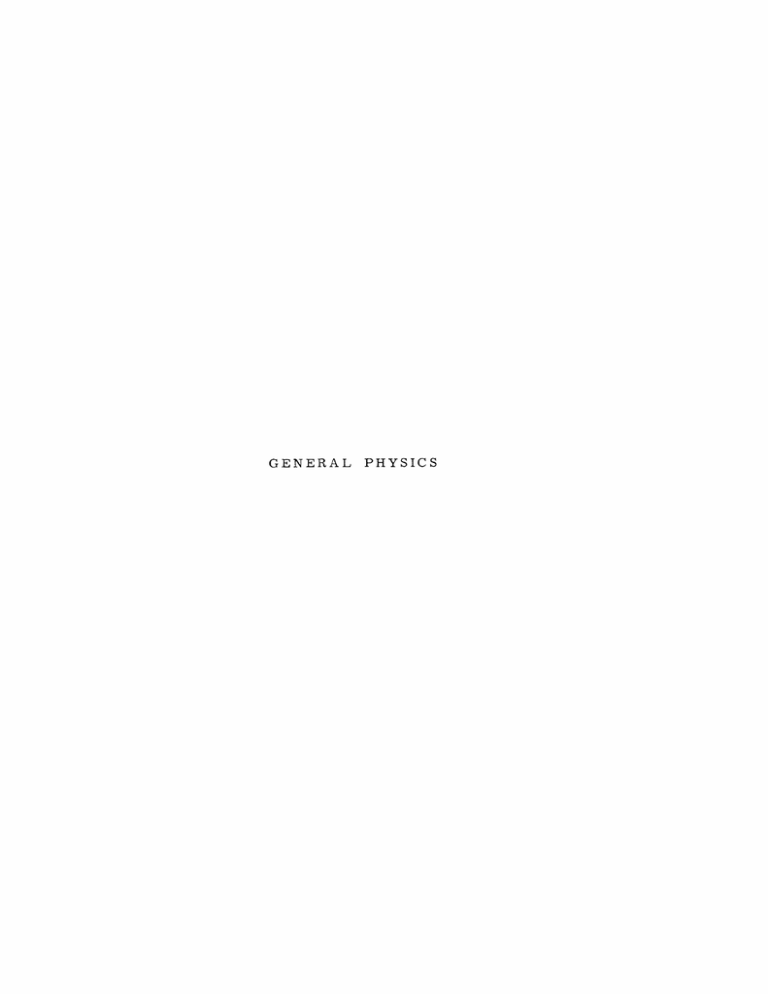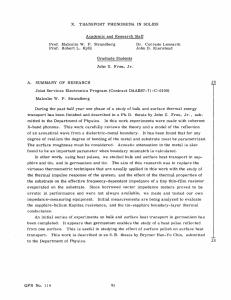PHYSICS GENERAL
advertisement

GENERAL PHYSICS I I. MICROWAVE SPECTROSCOPY Academic and Research Staff Prof. M. W. P. Strandberg Prof. R. L. Kyhl Dr. J. M. Andrews A. Fukumoto Dr. M. U. Palma Dr. Maria B. Palma-Vittorelli J. G. Ingersoll J. D. Kierstead Graduate Students J. U. Free, Jr. R. M. Langdon, Jr. A. S. R. Reznek B. N. Yung M. K. Maul T. E. McEnally ELECTRONIC CONTRIBUTION TO 9-GHz ULTRASONIC ATTENUATION IN THIN FILMS AT LOW TEMPERATURES The low-temperature ultrasonic reflection coefficients of thin films of tin have been studied in order to determine the electronic contribution to the ultrasonic attenuation In these experiments, tin films between 1. 2 -V. and 3.6-p. thickness have been deposited onto the end of an x-cut quartz rod. The opposite end of the quartz rod was excited piezoelectrically by means of an X-band re-entrant cavity. Ultrasonic coefficient at 9 GHz. echo pulses reflected from the tin film back to the re-entrant cavity were monitored as the film was switched between the superconducting and normal states by means of an external magnetic field. A diagram of the experimental apparatus is shown in Fig. I-i. The details of the ultrasonic energy-flow within a film, x 0 cm thick, are shown in IOGC PHONONS MICROWAVE PULSE ECHOES SUPERCONDUCTING FILM X-CUT QUARTZ ROD ECHO PULSES Fig. I-1. Apparatus for the observation of the microwave ultrasonic reflection coefficient of thin superconducting films. *This work was supported by the Joint Services Electronics Programs (U.S. Army, U.S. Navy, and U.S. Air Force) under Contract DA 36-039-AMC-03200(E). QPR No. 83 (I. MICROWAVE SPECTROSCOPY) Fig. 1-2. The quartz-metal boundary is characterized by a power reflection coeffi- cient R, and a power transmission coefficient T, so that R + T = 1. Losses in the tin film are characterized by an attenuation coefficient a (cm-1 -1). The far surface of the tin film is assumed to be perfectly reflecting, but rough so that only a fraction, F, of the incident power is specularly reflected with no loss in phase coherence. We shall deal only with the case of normal incidence. (The oblique incidence shown in Fig. I-2 is only for clarity in path presentation.) QUARTZ TIN Te -ax P -axo (1 - F) eTeax, P Fig. 1-2. Multiple reflection of ultrasound in a thin film. The total reflected power, power, Pr (watts), can be obtained as a function of the incident Pi (watts), by summing the geometric series representing multiple reflections within metallic the film. The ratio is denoted within the metallic film. The ratio is denoted I' -2ax 2 -ax o - 2FR e ocos R+Fe -2 ax -ax 0 1 +FRe 0-2"F-R e cos 2 . The quantity 4wx c o 0 QPR No. 83 (radians) is a measure of the phase retardation within the film. 4rvx v S o 0 (I. MICROWAVE SPECTROSCOPY) -i where X (cm) is the ultrasonic wavelength within the tin film, v (sec- ) is the frequency, and v 5 (cm/sec) is the ultrasonic velocity. s2 The power reflection coefficient r 2 approaches unity in two limits. When R - 1, no power enters the metallic film, and it is all returned to the generator (quartz losses are neglected). When a = 0 and F = 1, no loss or dispersion of ultrasound takes place within the metallic film. Again, in the case of normal incidence, all of the ultrasonic power is returned to the generator. The power reflection coefficient, R, at the interface between two solids can be represented by (4) 1 + Z2 R = where, for a lossless medium, Z i = Pi(vs)i (gm cm -zsec -1) is the ultrasonic impedance, Pi (gm cm-3) is the density of medium i, and (vs)i is the ultrasonic velocity in medium i. For a quartz-tin interface, the theoretical power reflection coefficient, evaluated for the longitudinal mode, is 0.048. For a nonideal interface, or when ultrasonic losses are large, the theoretical power reflection coefficient could be much larger. In the case of small R, we have an approximation of Eq. 2 that becomes exact in the limit x o - 0. -2 ax Fe 2 (5) 0. The ultrasonic attenuation coefficient a (cm 1) is viewed as being composed of two -1 - ) caused by grain-boundary scattering, crysportions: (i) a residual attenuation ao (cm talline imperfections, impurities, and other defects, and (ii) aelec (cm ) caused by the conduction electrons. The electronic component varies when the metal is switched between the normal and the superconducting states according to a s an _ 2 e2E(T)/k (6) T + 1 -i where E(T) (erg) is the superconducting energy gap, k (ergK- ) is Boltzmann's constant, and T ("K) is the absolute temperature. 2ax - 1 e ax) <<1, Eq. 5 is applicable, and the ratio of the ultrasonic (RF In the limit reflection coefficients for the superconducting versus the normal state of the metallic film can be expressed by 2ax - 1 D(T) (db) = 20 log 10 (s/n)= 20(an-as) x log 1 0 e RF e o can be eliminated by substituting Eq. 6. The temperature-dependent a s(T) s QPR No. 83 <<1. in Eq. 7. (7) (I. MICROWAVE SPECTROSCOPY) D(T) = Z0an(T) tanh kT x° logl 0 e. (8) Below 4*K, it is reasonable to assume that an (T) = a n(0) for a thin, polycrystalline film. In this case, D(T) D(0) = tanh L Lk T = 20an(0) x 0 log 1 0 e. (9) J We have made observations of D(T) for thin films of tin with thicknesses in the range 1.23.6 4. These measurements were made at temperatures below 2 0 K, and the temperature normalization defined by Eq. 9 yields corrections only of the order of a few parts per thousand. [2E(0) = 3.51 kTc]. The BCS value for the superconducting energy gap was used: These normalized measurements are shown in Fig. 1-3. Referring to Eq. 2, it is evident that as x - oo, D(0) - 0. x o , D(0) should exhibit oscillations caused by cos At intermediate values of 4. The theoretically expected behav- ior of D(0) is sketched in Fig. 1-4. The magnitude of the oscillation is controlled by the 3.0 - 2.5 - 2.0 / / / a n = 690 cm 1 .5 O / / 0 n = 410 cm 0 1 2 3 6 oFIRST ECHO values the ratio Fig. -3. ofExperimental 0.5 D( 5 O SECOND ECHO 0 THIRD ECHO 4 5 6 o0(P) Fig. 1-3. Experimental values of the ratio of the microwave ultrasonic reflection coefficient of a tin film as it is switched between the superconducting and normal states. ( r-D(O) = Z0 lOgl0 n/ QPR No. 83 I 5 3 10 2 v---- 01 0 2 3 5 4 9 8 7 6 xo (P) Fig. I-4. Theoretical behavior of D(O) = 20 log 1 0 (I's/ n), where Ss/r'n is defined by Eq. 2 with a = a 0n+ a fl . These -1curves have been drawn for R = 0.05, F = 1, a = 0.05 i , and ao/a n = 0, 1i, 3, 10. The periodic quantity cos C oscillates rapidly between the two limiting curves shown for each value of ao/an. The two vertical dashed lines show singularities in rs/Irn, where no signal can be detected in the normal state. This is caused by complete cancellation of the ultrasonic waves reflected from each of the two surfaces of the metallic film. At values of x 0 slightly higher than those that yield a singularity, the fraction Fs/F n becomes less than unity. The central dotted line, between the two limiting curves for ao/an = 0, represents the limiting behavior for R - 0 (see Eq. 9). QPR No. 83 5 (I. MICROWAVE values of R, F, SPECTROSCOPY) and a . If we evaluate the phase retardation 4 from Eq. 3 for the longi- tudinal mode in polycrystalline tin (v s = 3.3 X 10 cmsec - ) at 9 GHz, we find that one period of oscillation corresponds to a change in thickness of the tin film equal to 0.18 p.. This value is of the same order of magnitude as our measurement errors, so, without an appreciable increase in our optical resolution, it will not be possible to observe the oscillations in our experimental data. In Fig. I-3 there is good agreement among the data taken from multiple echoes. The small discrepancy in the data for different film thicknesses could be interpreted as being indicative of the magnitude of the oscillations. Further experiments, however, are needed to establish whether or not this is actually the case. A theoretical expression for the electronic contribution to the ultrasonic attenuation coefficient in metals has been worked out by Pippard. 1 It is given by an = 2 h / vn 4 / 3 cm , (10) v where p (gm/cm 3 ) is the density of the metal, N (atoms/mole) is Avogadro's number, W (gms/mole) is the atomic weight of the metal, h (erg sec) is Planck's constant, - 1 ) is the frequency of the vs(cm/sec) is the ultrasonic velocity in the metal, v (sec ultrasound, and n is the effective number of free electrons per atom. The chemical valance of tin can be either 2 or 4. Equation 10, evaluated for the longitudinal ultrasonic mode in tin at 9 GHz, yields Theoretical a n = 380 cm - 1 2 free electrons/atom an = 650 cm -1 3 free electrons/atom a n = 950 cm - 4 free electrons/atom 1 The two limiting slopes of our experimental data shown in Fig. I-3 yield 690 cm-1 a = an = 410 cm-1 Experimental These values suggest that some number between 2 and 3 electrons per atom in metallic tin is effective in the electronic contribution to ultrasonic attenuation. The author would like to acknowledge the experimental assistance of John U. Free, Jr. J. M. Andrews, Jr. References 1. A. B. Pippard, Rept. Progr. Phys. 23, QPR No. 83 176 (1960), Eq. 68, p. 242.





